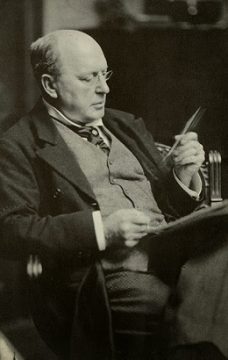Colm Toibin in Bookforum:
 Henry James did not wish to be known by his readers. He remained oddly absent in his fiction. He did not dramatize his own opinions or offer aphorisms about life, as George Eliot, a novelist whom James followed closely, did. Instead, he worked intensely on his characters, offering their consciousness and motives a great deal of nuance and detail and ambiguity. James was concerned with his privacy, burning many of the letters he received. Most of the time, he conducted his own correspondence with caution and care. But at the end of the nineteenth century and in the early years of the twentieth, when James was in his late fifties and early sixties, he began to write letters to younger men whose tone had a mixture of open affection and something that is more difficult to define.
Henry James did not wish to be known by his readers. He remained oddly absent in his fiction. He did not dramatize his own opinions or offer aphorisms about life, as George Eliot, a novelist whom James followed closely, did. Instead, he worked intensely on his characters, offering their consciousness and motives a great deal of nuance and detail and ambiguity. James was concerned with his privacy, burning many of the letters he received. Most of the time, he conducted his own correspondence with caution and care. But at the end of the nineteenth century and in the early years of the twentieth, when James was in his late fifties and early sixties, he began to write letters to younger men whose tone had a mixture of open affection and something that is more difficult to define.
For example, on February 25, 1900, he wrote to the writer Howard Sturgis, then forty-five: “I repeat, almost to indiscretion, that I could live with you. Meanwhile I can only try to live without you.” On May 19, 1912, he ended a letter to the writer Hugh Walpole, twenty-eight at the time, with: “I don’t know how to tell you vividly enough how yearningly I pat you on the back or in fact take you to the heart. But feel it, know it, like it.”
These letters and some late stories, such as “The Beast in the Jungle” and “The Jolly Corner,” are the only clues we get from James about his secret desires. Many of his readers have tried to find clarity in James when there is obfuscation, a definite sexual identity for him when he sought, using artistry, to disguise himself, to conceal himself behind an elaborate prose style and an intricate architecture for his novels. The cultivation of secrecy in James’s life and work was not merely a strategy he used during his time in England, a time when homosexuality, as we learn from the Wilde case, could be punished severely. It is not simply that he kept things to himself so that he would not be ruined by disclosure. Rather, sexual secrecy and disclosure became his great subject as an artist. His four best novels—The Portrait of a Lady (1881), The Wings of the Dove (1902), The Ambassadors (1903), and The Golden Bowl (1904)—are animated by a story of a liaison that if revealed will be explosive.
More here.
